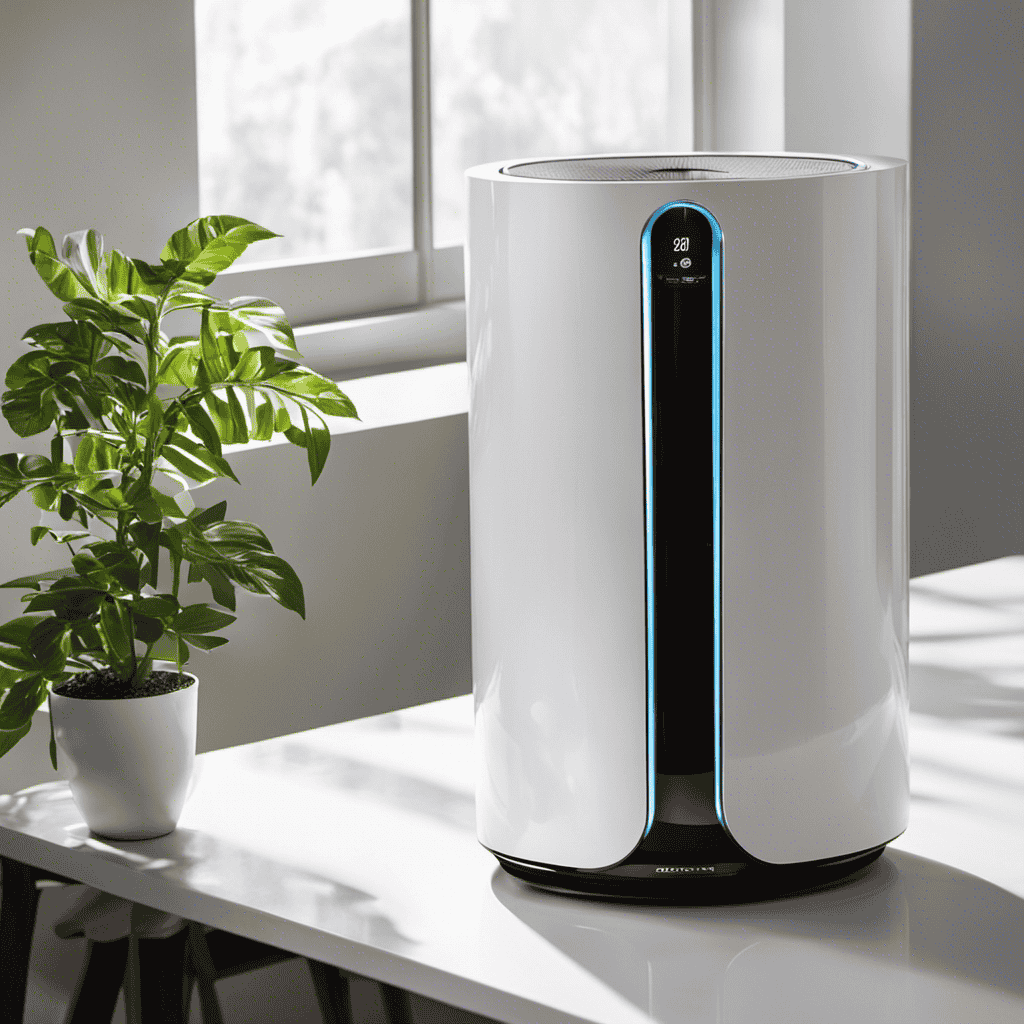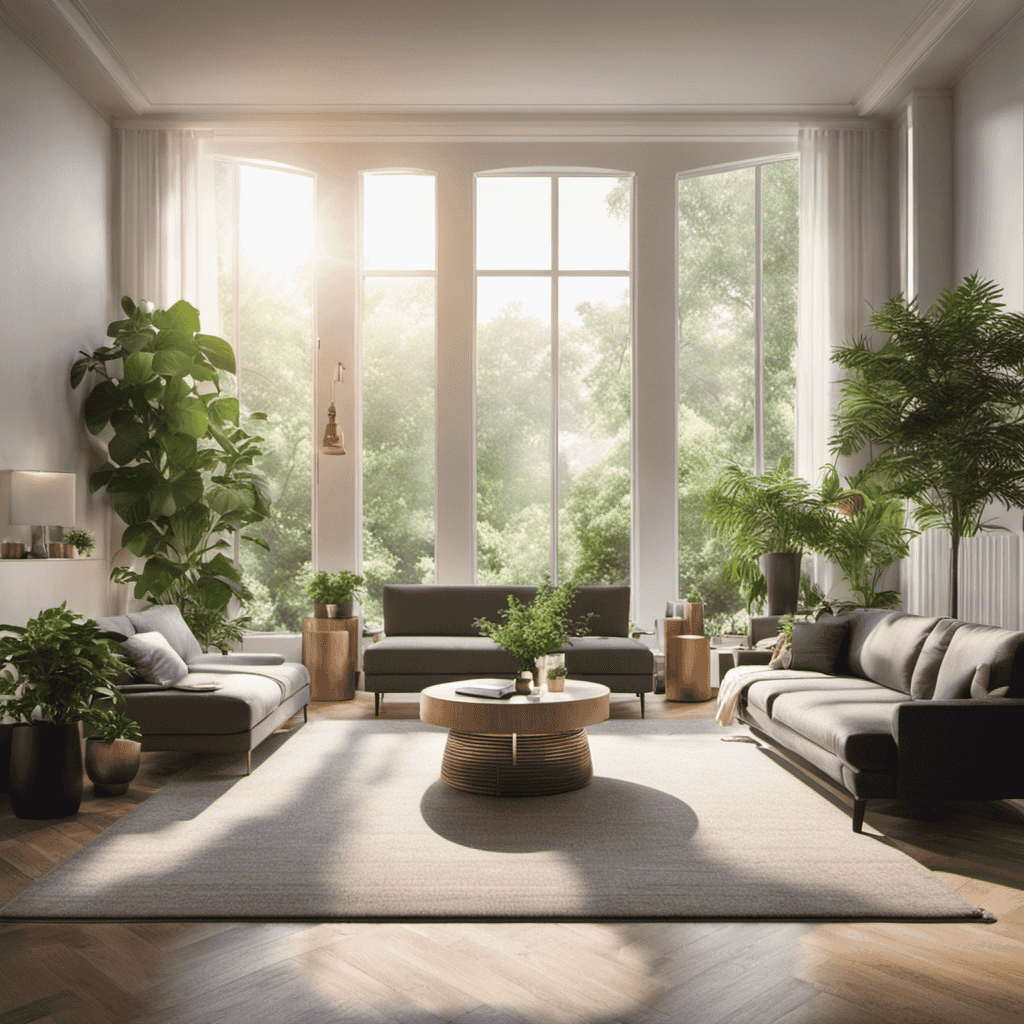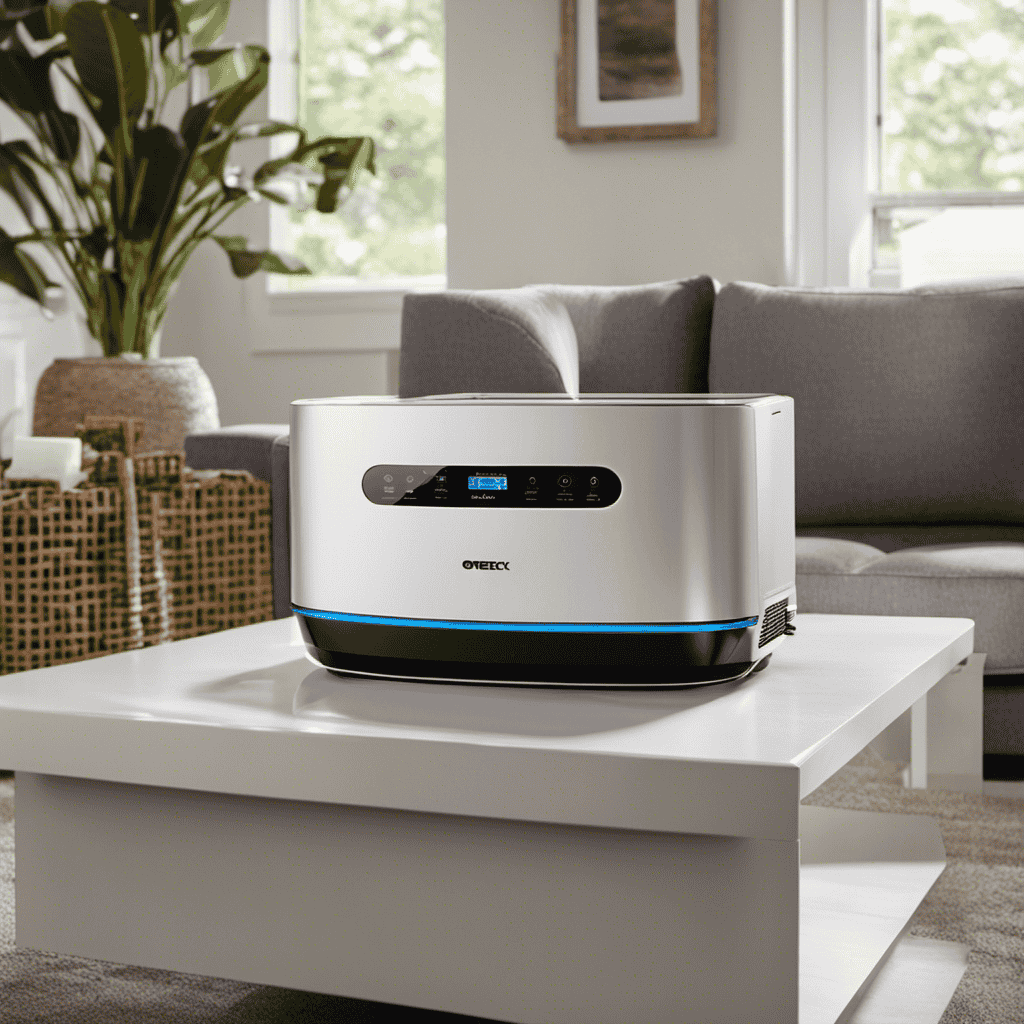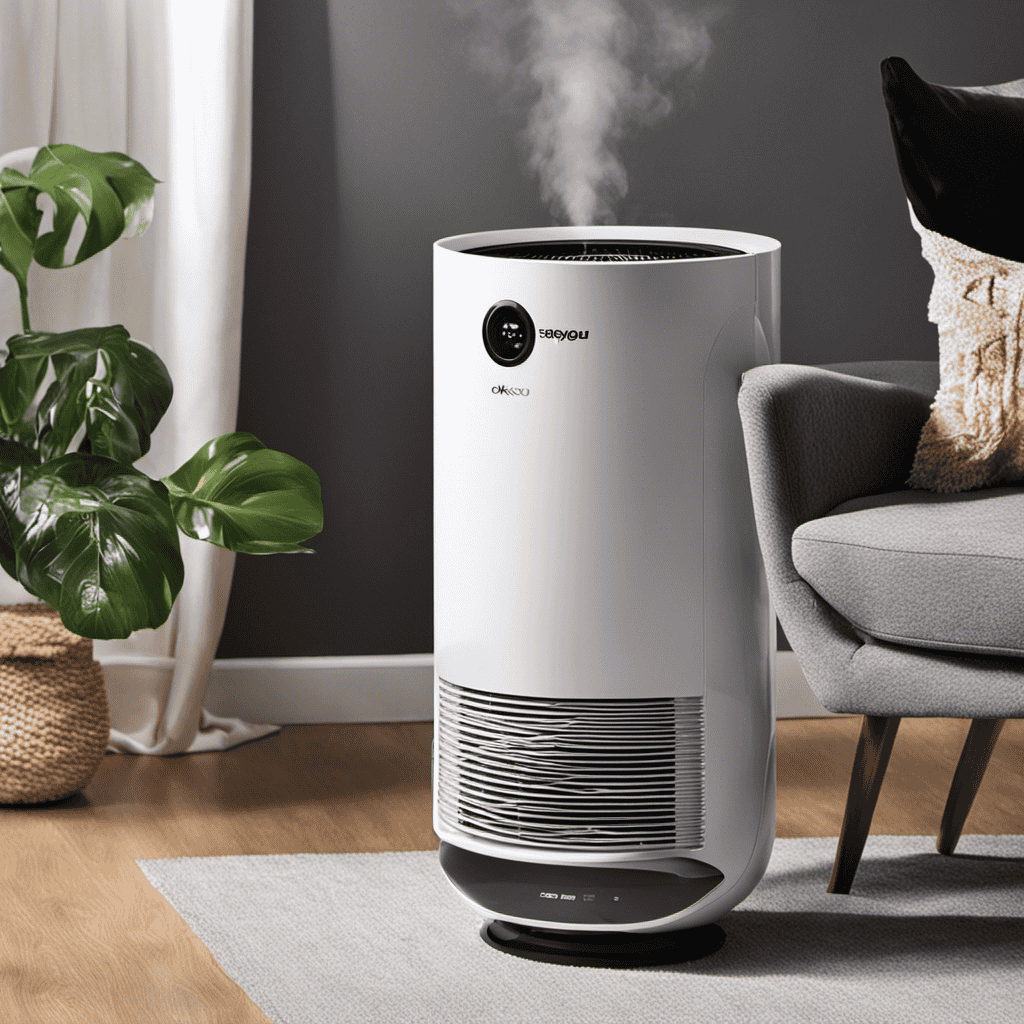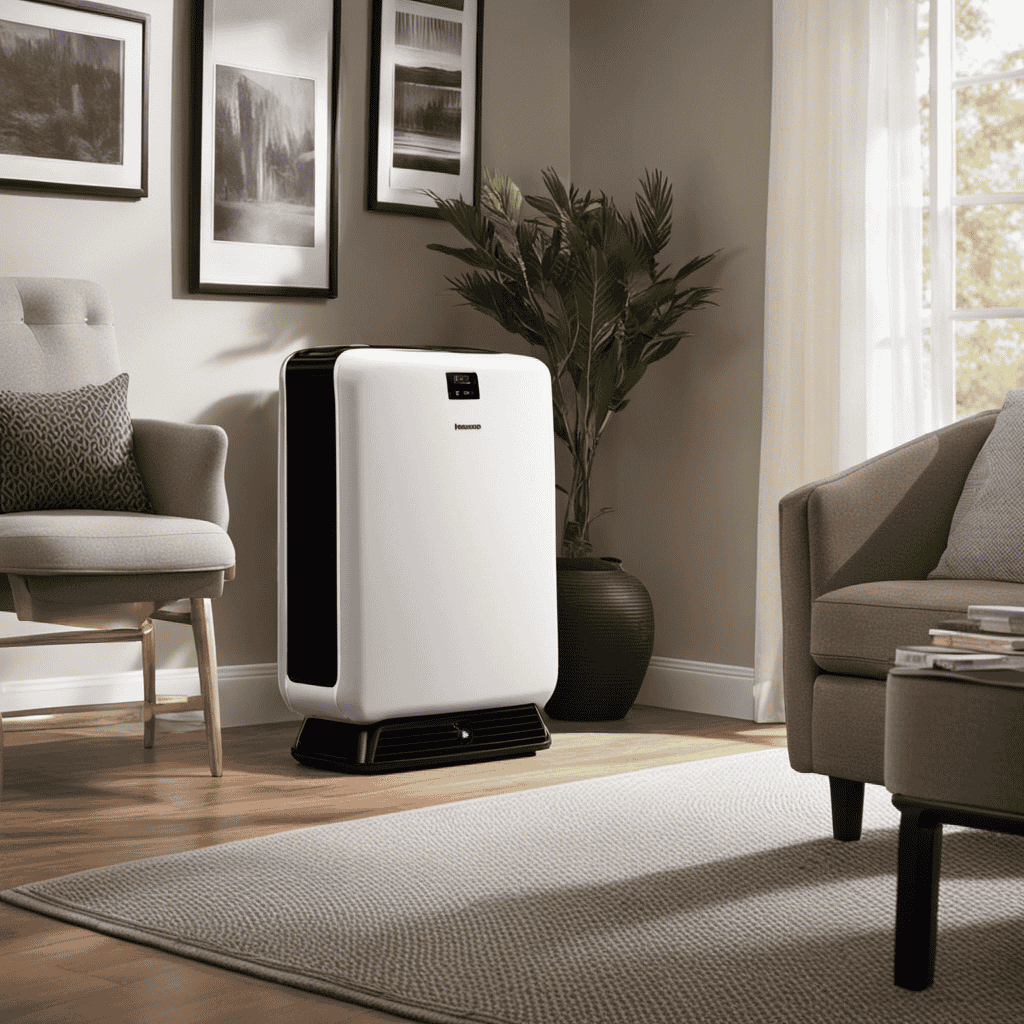Oh man, do I have a tale to tell you. The amount of time and effort I dedicated to finding a quality air purifier was unbelievable. Trust me, it was quite an adventure. But don’t worry, my fellow clean air fans, I’ve conducted the research and I’m ready to pass along my discoveries.
In this article, we’ll dive into the different types of air purifiers, key features to look for, and the various technologies used. So sit back, relax, and get ready to breathe in that sweet, purified air.
Key Takeaways
- Good air purifiers should have efficient filtration methods, such as HEPA filters, to effectively trap airborne particles.
- They should also incorporate activated carbon adsorption to absorb gases, odors, and VOCs.
- Noise level considerations are crucial, and customer reviews can provide insights on the noise levels of different air purifiers.
- Regular maintenance, including filter replacement and proper ventilation, is essential for optimal air purifier performance and longevity.
Types of Air Purifiers
If you’re looking for an air purifier, there are two main types to consider: mechanical filters and electronic air cleaners. Both types have their own benefits and maintenance requirements.
Mechanical filters work by trapping airborne particles in a physical filter, such as a HEPA filter, which is then replaced periodically to maintain its effectiveness. These filters are highly efficient at removing dust, pollen, pet dander, and other larger particles from the air.
On the other hand, electronic air cleaners use ionization or electrostatic attraction to capture and remove particles from the air. They require regular cleaning to remove accumulated particles from the plates or cells.
Regardless of the type you choose, regular maintenance is essential to ensure optimal performance and reap the benefits of cleaner indoor air.
Key Features to Look for in an Air Purifier
When considering an air purifier, there are two key points to keep in mind: effective filtration methods and noise level considerations.
Effective filtration methods are crucial for ensuring that the air purifier can effectively remove pollutants and allergens from the air.
Noise level considerations are important because a noisy air purifier can be disruptive, especially if you plan to use it in a bedroom or office setting.
Effective Filtration Methods
One effective way to filter air is by using high-efficiency particulate air (HEPA) filters. HEPA filters are known for their high filter efficiency, capable of removing up to 99.97% of particles as small as 0.3 microns. This includes common allergens like dust, pollen, pet dander, and mold spores.
HEPA filters work by trapping these particles within their dense fibers, preventing them from circulating back into the air. To further enhance air purification, some air purifiers also incorporate activated carbon adsorption. Activated carbon is highly porous and has the ability to absorb various gases, odors, and volatile organic compounds (VOCs). This can help to improve indoor air quality by reducing unwanted smells and chemical pollutants.
Considering the efficiency of HEPA filters and the additional benefits of activated carbon adsorption, these filtration methods are essential when looking for a good air purifier.
Now, let’s move on to the next consideration: noise levels.
Noise Level Considerations
To ensure a quiet environment, you should consider the noise levels of different air purifiers. When looking for an air purifier, it’s important to consider the noise it produces, especially if you plan on using it in a bedroom or office space. Different air purifier brands offer varying noise levels, so it’s worth doing your research and reading customer reviews to find one that suits your needs.
Some air purifiers are designed to operate quietly, with noise levels as low as 20 decibels, while others may produce a higher amount of noise. By reading customer reviews, you can get a better understanding of the noise level of a specific air purifier and make an informed decision based on real experiences.
Understanding Air Purification Technologies
If you want to understand air purification technologies, you should research HEPA filters and activated carbon filters.
HEPA filters are designed to capture tiny particles in the air, such as dust, pollen, and pet dander, while activated carbon filters are effective at removing odors, chemicals, and volatile organic compounds (VOCs) from the air.
These filters work together to provide a comprehensive air purification solution.
Maintaining your air purifier is essential to ensure its optimal performance. Regularly cleaning or replacing the filters, as recommended by the manufacturer, is important to keep the air purifier functioning efficiently.
The benefits of using an air purifier are numerous. They can improve indoor air quality, reduce allergy symptoms, remove harmful pollutants, and create a healthier living environment.
Size and Coverage Area of Air Purifiers
The size and coverage area of air purifiers vary depending on the model and brand you choose. When considering the size of an air purifier, there are a few factors to keep in mind.
First, assess the size of the room where you plan to use the purifier. A larger room may require a purifier with a higher coverage area to effectively clean the air.
Second, consider the placement of the purifier within the room. If it will be placed near a wall or in a corner, ensure that the purifier’s size allows for proper air circulation.
Lastly, think about the portability of the purifier. If you plan to move it from room to room, a smaller and lighter model may be more convenient.
To keep your air purifier running efficiently, regular maintenance is essential. This includes cleaning or replacing filters, checking for any clogs, and ensuring proper ventilation.
Noise Level Considerations
Consider the noise level when selecting an air purifier, as it can greatly impact your overall comfort and peace of mind. Nobody wants a loud and distracting purifier disrupting their daily activities or sleep. Look for air purifiers that offer silent operation or have low sound level measurements. These measurements are usually expressed in decibels (dB) and can give you an idea of how loud or quiet the purifier will be.
A good air purifier should have a noise level of around 30-40 dB, which is equivalent to a whisper or a quiet library. By choosing a purifier with silent operation, you can ensure a peaceful and undisturbed environment in your home.
Now, let’s move on to another important consideration: energy efficiency and operating costs.
Energy Efficiency and Operating Costs
When selecting an air purifier, you should look for models that offer energy efficiency and low operating costs. Energy saving features are essential to reduce electricity consumption and minimize your carbon footprint. Additionally, a cost-effective operation ensures that you can enjoy clean air without breaking the bank.
Here are three reasons why energy efficiency and low operating costs are important when choosing an air purifier:
-
Environmental Impact: By opting for an energy-efficient model, you can contribute to a greener future by reducing greenhouse gas emissions.
-
Long-Term Savings: Air purifiers with low operating costs can save you money in the long run, allowing you to enjoy clean air without worrying about hefty electricity bills.
-
Sustainability: Energy-efficient air purifiers promote sustainable living practices, aligning with your values and commitment to preserving the environment.
Considering these factors will help you make an informed decision and choose an air purifier that is both environmentally friendly and cost-effective.
Filter Replacement and Maintenance
Regular filter replacement and maintenance are essential for optimal performance and longevity of an air purifier. Neglecting these tasks can lead to decreased efficiency and increased filter replacement costs in the long run.
To ensure that your air purifier operates at its best, it is recommended to follow a few maintenance tips.
Firstly, check the manufacturer’s instructions for guidelines on how often to replace the filters. This can vary depending on the model and usage.
Additionally, it is advisable to vacuum the pre-filter regularly to remove larger particles and debris. This will prevent the main filters from getting clogged too quickly.
Effectiveness in Removing Allergens
To ensure your air purifier is working efficiently, it’s important to regularly replace and maintain the filters. Here are some air purifier maintenance tips to help you keep your unit in top shape:
-
Clean or replace the pre-filter: This helps to extend the lifespan of your main filter and prevent it from clogging up quickly.
-
Vacuum the unit: Dust and debris can accumulate on the exterior and vents of your air purifier, so giving it a regular vacuuming can improve its performance.
-
Check the filter indicator: Many air purifiers have a filter replacement indicator that alerts you when it’s time to change the filters. Pay attention to these indicators to ensure optimal air purification.
Using an air purifier has several benefits, such as reducing indoor air pollution, alleviating allergy symptoms, and improving overall air quality.
As we move on to discussing removing odors and volatile organic compounds (VOCs), it’s important to note that air purifiers can effectively address these issues as well.
Removing Odors and Volatile Organic Compounds (VOCs
When it comes to eliminating odors and reducing volatile organic compounds (VOCs), there are a variety of techniques and methods that can be used.
From activated carbon filters to ozone generators, different approaches can be effective depending on the specific situation and type of odor or VOC.
It is important to consider the potential health effects and environmental impact of these techniques, as well as their ability to effectively remove the odors and reduce VOC levels.
Odor Elimination Techniques
One of the best air purifiers for eliminating odors is the one that uses activated carbon filters. These filters are highly effective at trapping and neutralizing odor-causing molecules in the air.
Here are three reasons why activated carbon filters are a great choice for odor elimination:
-
Powerful adsorption: Activated carbon has a large surface area with countless tiny pores that can adsorb a wide range of odor molecules, including smoke, pet odors, and cooking smells.
-
Long-lasting effectiveness: Activated carbon filters can continue to eliminate odors for an extended period before needing to be replaced, ensuring constant freshness in your space.
-
Safe and eco-friendly: Activated carbon is a natural material that is non-toxic and environmentally friendly, making it a safe choice for air purification.
VOC Reduction Methods
Now that we have discussed odor elimination techniques, let’s explore VOC reduction methods.
VOCs, or volatile organic compounds, are harmful chemicals that can be found in many household products and materials. These compounds can contribute to poor indoor air quality and have been linked to various health issues.
To effectively reduce VOC levels in your home, there are several techniques you can employ. One common method is to increase ventilation by opening windows or using exhaust fans. Another approach is to choose products with low VOC emissions, such as paints, furniture, and cleaning supplies labeled as VOC-free or low VOC.
Additionally, using air purifiers with activated carbon filters can help trap and remove VOCs from the air. These filters are designed to absorb the chemicals, improving the overall air quality in your home.
Implementing these VOC reduction techniques can have numerous benefits, including improved respiratory health, reduced allergy symptoms, and a fresher, cleaner living environment.
Now, let’s delve into the next section about air purifiers specifically designed for asthma and allergy relief.
Air Purifiers for Asthma and Allergy Relief
If you suffer from asthma or allergies, you’ll want to consider getting an air purifier specially designed to provide relief for these conditions. Air purifiers can help remove allergens from the air, improving indoor air quality and reducing symptoms.
Here are three key features to look for in an air purifier for asthma and allergy relief:
-
HEPA filtration: High Efficiency Particulate Air (HEPA) filters can capture particles as small as 0.3 microns, including pet dander and mold spores. This can greatly reduce allergens in your home.
-
Activated carbon filter: These filters can help remove odors and chemicals from the air, which can be beneficial for pet owners who may have pet-related odors or for those concerned about mold and mildew prevention.
-
Air quality sensors: Some air purifiers have built-in sensors that can detect and automatically adjust the fan speed based on the air quality in the room. This ensures that the purifier is working efficiently to keep the air clean.
Air Purifiers for Pet Owners
When considering air purifiers for pet owners, it’s important to look for filters that can effectively remove pet-related odors and allergens from the air. Pet dander, a common allergen, can cause discomfort and allergic reactions in sensitive individuals.
To address this issue, air purifiers with HEPA filters are recommended as they can capture and trap tiny particles like pet dander. These filters have a high efficiency rate and can remove up to 99.97% of airborne particles as small as 0.3 microns.
Additionally, activated carbon filters are effective in eliminating pet odors by adsorbing the odor molecules. Air purifiers that combine both HEPA and activated carbon filters provide comprehensive pet dander control and can significantly improve indoor air quality for pet owners with allergies.
Air Purifiers for Smokers and Secondhand Smoke
To effectively address the issue of secondhand smoke and improve indoor air quality for smokers, you should consider using air purifiers with specialized filters that can efficiently remove smoke particles and eliminate lingering odors. These air purifiers are specifically designed to combat the harmful effects of cigarette smoke and provide a healthier environment for everyone in the household.
Here are three reasons why air purifiers are a great investment for smokers:
-
Health benefits: Air purifiers can help reduce the health risks associated with secondhand smoke, such as respiratory problems and cardiovascular diseases. By removing smoke particles and pollutants from the air, they can create a cleaner and safer living space.
-
Odor elimination: One of the biggest concerns for smokers is the lingering smell of smoke. Air purifiers with activated carbon filters can effectively eliminate odors, leaving your home smelling fresh and clean.
-
Versatility: Air purifiers designed for cigarette smoke can also be used to combat other types of smoke, like wildfire smoke. They can help remove harmful particles and improve indoor air quality during times of poor air quality due to wildfires.
Investing in a high-quality air purifier is a proactive step towards improving indoor air quality for smokers and reducing the health risks associated with secondhand smoke.
Air Purifiers for Dust and Pollen Removal
When it comes to air purifiers for dust and pollen removal, there are a few key factors to consider.
One important aspect is effective allergen filtration, which ensures that the purifier can effectively capture and remove these particles from the air.
Another factor to look for is quiet operation during use, as this allows the purifier to run without causing too much noise or disruption.
Lastly, energy-efficient purification technology is crucial, as it not only helps to save on electricity costs but also reduces the environmental impact of the purifier.
Effective Allergen Filtration
You should look for an air purifier that effectively filters allergens to improve your indoor air quality. When it comes to allergen removal methods, there are several factors to consider for air purifier effectiveness:
-
HEPA filtration: Look for an air purifier that uses a High-Efficiency Particulate Air (HEPA) filter. These filters are designed to capture particles as small as 0.3 microns, including common allergens like dust mites, pollen, pet dander, and mold spores.
-
Activated carbon filtration: An air purifier with activated carbon filters can help remove odors and volatile organic compounds (VOCs) that can trigger allergies.
-
Air exchange rate: Consider the air exchange rate of the air purifier, which indicates how many times it can filter the air in a room per hour. A higher air exchange rate means more efficient allergen removal.
Quiet Operation During Use
Moving on to the next important factor in choosing a good air purifier – quiet operation during use.
Many people prefer air purifiers that operate silently, especially if they plan to use them in bedrooms or other quiet spaces. Fortunately, there are various noise reduction techniques employed by manufacturers to achieve this.
One common technique is using advanced fan designs that minimize noise while providing efficient air circulation. Additionally, some models feature noise-absorbing materials or soundproofing technology to further reduce operational noise.
When researching air purifiers, it is worth checking the decibel rating provided by the manufacturer to get an idea of how quiet the unit will be during use.
Energy-Efficient Purification Technology
If you want an air purifier that uses energy efficiently, look for models that utilize advanced purification technology. These energy-efficient designs not only provide clean air but also help reduce your carbon footprint.
Here are three reasons why energy-efficient air purifiers are a great choice:
-
Lower electricity bills: Energy-efficient air purifiers consume less power, resulting in lower energy costs. You can enjoy clean air without worrying about skyrocketing electricity bills.
-
Environmental impact: By opting for an energy-efficient design, you contribute to reducing greenhouse gas emissions. These purifiers use less energy, which helps conserve natural resources and protect the environment.
-
Longer lifespan: Energy-efficient air purifiers are often built with high-quality components that require less maintenance. This means fewer repairs and replacements, resulting in long-term savings.
By investing in an energy-efficient air purifier, you not only save money but also play a part in creating a sustainable future.
Now, let’s explore how air purifiers can help prevent mold and mildew.
Air Purifiers for Mold and Mildew Prevention
There’s no better way to prevent mold and mildew than using a good air purifier.
When it comes to choosing an air purifier for mold and mildew prevention, it’s important to consider models that are effective at removing bacteria, viruses, and chemical fumes from the air. Look for air purifiers with HEPA filters, as they are known to capture small particles such as mold spores and bacteria. Activated carbon filters are also helpful in removing chemical fumes and odors.
It’s important to note that while air purifiers can help prevent mold and mildew, they should be used in conjunction with proper ventilation and moisture control in order to fully address the issue.
Air Purifiers for Improving Indoor Air Quality
When it comes to choosing an air purifier to improve indoor air quality, there are a few key points to consider.
First, understanding the different types of filters available is important. HEPA filters are known for their effectiveness in removing airborne particles, while activated carbon filters can help eliminate odors and chemicals.
Second, noise level considerations are crucial, especially if you plan to use the air purifier in a bedroom or office setting. Look for models with adjustable fan speeds or a quiet mode to ensure minimal disruption.
Lastly, consider the coverage area options of the air purifier. It’s important to choose a model that can effectively clean the air in the size of the room or space you’re targeting.
Filter Types Explained
The most common filter types used in air purifiers are HEPA, activated carbon, and ionizers. When it comes to filter maintenance, it’s crucial to keep them clean and replace them regularly to ensure optimal performance.
Here are three reasons why clean air is important for your health and well-being:
-
Reduction of allergens: Clean air filters can remove allergens such as pollen, pet dander, and dust mites, providing relief for allergy sufferers.
-
Improved respiratory health: Breathing in clean air reduces the risk of respiratory issues like asthma and bronchitis, promoting better lung function.
-
Enhanced sleep quality: Clean air helps reduce snoring and improve sleep quality, allowing you to wake up feeling refreshed and rejuvenated.
By understanding the importance of clean air and maintaining your air purifier’s filters, you can create a healthier indoor environment.
Now, let’s explore another important consideration when choosing an air purifier: noise level.
Noise Level Considerations
Now that we understand the different types of filters, let’s discuss another important consideration when choosing an air purifier: noise level. Many people prefer a silent operation, especially when using the device in their bedrooms or offices. To determine the noise level, manufacturers provide sound level measurements in decibels (dB). It is important to look for air purifiers that have low sound levels, typically below 50 dB, which is equivalent to the sound of a quiet conversation. To help you compare different air purifiers, here is a table displaying the sound level measurements of some popular models:
| Air Purifier Model | Sound Level (dB) |
|---|---|
| Model A | 40 dB |
| Model B | 45 dB |
| Model C | 50 dB |
| Model D | 55 dB |
| Model E | 60 dB |
Coverage Area Options
To find an air purifier that suits your needs, you’ll want to consider the coverage area options. Having an air purifier that can effectively clean the air in your specific space is crucial for maintaining a healthy indoor environment. Here are three reasons why coverage area is important when choosing an air purifier:
-
Clean Air for Everyone: A larger coverage area means that more people can benefit from clean air. Whether it’s your family at home or employees in the office, ensuring that everyone breathes fresh and pollutant-free air is essential for their health and well-being.
-
Efficient Air Purification: A purifier with a coverage area that matches your room size will be more efficient in removing allergens, dust, and pollutants. This means that the air in your space will be cleaner and healthier in a shorter amount of time.
-
Cost-Effective Solution: Investing in an air purifier that covers your entire room or space will save you money in the long run. It will effectively clean the air in that area, reducing the need for additional purifiers or costly maintenance.
Considering the coverage area options when selecting an air purifier is crucial for ensuring that you and your loved ones have access to clean and healthy air.
What Are the Features to Look for in a Good Air Purifier?
When considering what makes a good air purifier, look for advanced filtration systems to remove allergens, pollutants, and odors. A strong fan to efficiently circulate air is also crucial. Additionally, consider the CADR rating for specific pollutants and the size and coverage area of the purifier.
Frequently Asked Questions
Can an Air Purifier Eliminate All Types of Allergens, Including Pollen, Dust, and Mold?
Yes, an air purifier can eliminate various allergens such as pollen, dust, and mold. It is important to choose a high-quality air purifier and regularly maintain it for optimal effectiveness in removing these allergens.
How Often Do Air Purifier Filters Need to Be Replaced, and What Is the Cost?
Replacing air purifier filters is important for maintaining optimal performance. The frequency of replacement depends on usage and the specific model. It’s essential to check the manufacturer’s guidelines for the recommended schedule. The cost of replacement filters varies, but it’s an investment in cleaner air.
Can an Air Purifier Completely Eliminate Odors and Volatile Organic Compounds (Vocs) From the Air?
Yes, an air purifier can effectively eliminate odors and volatile organic compounds (VOCs) from the air. The technology used in air purifiers helps to filter and neutralize these pollutants, providing numerous benefits for indoor air quality.
Are There Specific Air Purifiers Designed for People With Asthma and Allergies?
Yes, there are air purifiers designed for people with asthma and allergies. They help remove allergens and irritants from the air, creating a healthier environment. Additionally, some models are specifically designed for pets and small spaces.
Can Air Purifiers Effectively Remove Secondhand Smoke Particles From the Air?
Yes, air purifiers can effectively remove cigarette smoke particles from the air. They are designed to capture and filter out airborne pollutants, including smoke particles, improving indoor air quality.
Conclusion
After carefully researching and analyzing various types of air purifiers, it is clear that finding a good air purifier is crucial for improving indoor air quality.
With a plethora of options available, it is important to consider key features such as air purification technologies, size and coverage area, and noise level.
Whether you’re battling secondhand smoke, dust, pollen, or mold, a reliable air purifier can be your knight in shining armor, swooping in to clean the air and create a fresh, rejuvenating atmosphere in your home.
Take a deep breath and let the air purifier work its magic!
